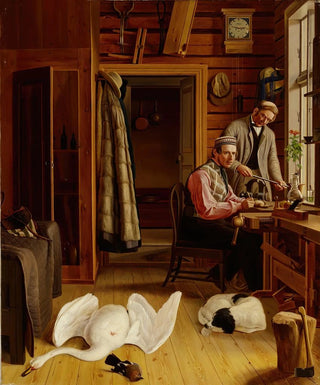Art print | Interior of the Marieberg workshop - Ferdinand von Wright


View from behind

Frame (optional)
Interior art print of the Marieberg workshop - Ferdinand von Wright – Captivating introduction
In the bustling universe of art, some works manage to transcend the simple frame of the canvas to offer a truly immersive experience. "Interior of the Marieberg workshop" by Ferdinand von Wright is a perfect example. This piece immerses us in the creative intimacy of the artist, revealing a space where light, colors, and objects combine to tell a unique story. The art print of this iconic work not only allows for a deeper understanding of Wright's universe but also enables appreciation of the depth of his artistic vision, while inviting the viewer to reflect on the creative process and the very nature of inspiration.
Style and uniqueness of the work
Ferdinand von Wright's style is characterized by striking realism, combined with poetic sensitivity. In "Interior of the Marieberg workshop," the artist employs a palette of delicate colors that evoke natural light filtering through the workshop windows. The objects arranged within the space—whether brushes, canvases, or furniture—are rendered with meticulous precision, demonstrating careful attention to detail. The atmosphere emanating from this work is both serene and inspiring, inviting the viewer to feel the artist's passion for his craft. Wright manages to capture the very essence of artistic creation, transforming a simple workshop into a place of magic and reflection.
The artist and his influence
Ferdinand von Wright, born in Finland in 1803, is a significant figure of the 19th-century art movement. His work stands out for its ability to combine a realistic view of the world with romantic sensitivity. Influenced by Finnish landscapes and the surrounding nature, Wright skillfully integrated these elements into his compositions, creating a dialogue between art and the natural world. His work not only contributed to the flourishing of art in Finland but also influenced many contemporary artists. As a pioneer of realism, he paved the way for a more authentic and introspective approach to art, encouraging his peers to explore more personal and intimate themes. "Interior of the

Matte finish

View from behind

Frame (optional)
Interior art print of the Marieberg workshop - Ferdinand von Wright – Captivating introduction
In the bustling universe of art, some works manage to transcend the simple frame of the canvas to offer a truly immersive experience. "Interior of the Marieberg workshop" by Ferdinand von Wright is a perfect example. This piece immerses us in the creative intimacy of the artist, revealing a space where light, colors, and objects combine to tell a unique story. The art print of this iconic work not only allows for a deeper understanding of Wright's universe but also enables appreciation of the depth of his artistic vision, while inviting the viewer to reflect on the creative process and the very nature of inspiration.
Style and uniqueness of the work
Ferdinand von Wright's style is characterized by striking realism, combined with poetic sensitivity. In "Interior of the Marieberg workshop," the artist employs a palette of delicate colors that evoke natural light filtering through the workshop windows. The objects arranged within the space—whether brushes, canvases, or furniture—are rendered with meticulous precision, demonstrating careful attention to detail. The atmosphere emanating from this work is both serene and inspiring, inviting the viewer to feel the artist's passion for his craft. Wright manages to capture the very essence of artistic creation, transforming a simple workshop into a place of magic and reflection.
The artist and his influence
Ferdinand von Wright, born in Finland in 1803, is a significant figure of the 19th-century art movement. His work stands out for its ability to combine a realistic view of the world with romantic sensitivity. Influenced by Finnish landscapes and the surrounding nature, Wright skillfully integrated these elements into his compositions, creating a dialogue between art and the natural world. His work not only contributed to the flourishing of art in Finland but also influenced many contemporary artists. As a pioneer of realism, he paved the way for a more authentic and introspective approach to art, encouraging his peers to explore more personal and intimate themes. "Interior of the






